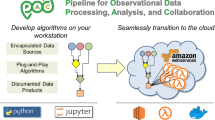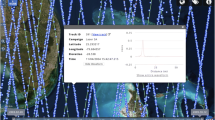Abstract
Web interfaces have made remote sensing image resources more accessible and interactive. However, many web-based and Digital Earth opportunities for remote sensing have not yet been fully explored and could greatly facilitate scientific collaboration. In many cases, these resources can augment traditional proprietary software packages, which can have limited flexibility, spatiotemporal controls, and data synthesis abilities. In this paper, we discuss how web services and Google Earth were used for time-critical geovisualizations of the NASA Airborne Visible/Infrared Imaging Spectrometer (AVIRIS) Deepwater Horizon oil spill imaging campaign. In particular, we describe how (1) AVIRIS Google Earth products were used to visualize the spatial and temporal characteristics of the campaign’s image acquisitions, critically needed for flight planning, (2) the Google Fusion Table cloud-based service was applied to create a highly-interactive image archive and mapping display, and (3) the Google Fusion Table API was utilized to create a flexible PHP-based interface for metadata creation and as the basis for an interactive data catalog. Although there are other possible software and programming approaches to these activities, we highlight freely-accessible and flexible solutions and bring attention to the newly introduced Google Fusion Tables as a collaborative scientific platform.





Similar content being viewed by others
References
Aguilera F, Méndez J, Pásaro E, Laffon B (2010) Review on the effects of exposure to spilled oils on human health. J Appl Toxicol 30(4):291–301. doi:10.1002/jat.1521
Athanasis N, Kalabokidis K, Vaitis M, Soulakellis N (2009) Towards a semantics-based approach in the development of geographic portals. Comput Geosci 35(2):301–308. doi:10.1016/j.cageo.2008.01.014
Ballagh LM, Raup BH, Duerr RE, Khalsa SJS, Helm C, Fowler D, Gupte A (2011) Representing scientific data sets in KML: methods and challenges. Comput Geosci 37(1):57–64. doi:10.1016/j.cageo.2010.05.004
Brynko B (2008) Research 2.0: the age of collaboration. Inform Today 25(8):34
Butler D (2006) Virtual globes: the web-wide world. Nature 439(7078):776–778
Chen A, Leptoukh G, Kempler S, Lynnes C, Savtchenko A, Nadeau D, Farley J (2009) Visualization of A-Train vertical profiles using Google Earth. Comput Geosci 35(2):419–427. doi:10.1016/j.cageo.2008.08.006
Clark RN, Swayze GA, Leifer I, Livo KE, Kokaly R, Hoefen T, Lundeen S, Eastwood M, Green RO, Pearson N, Sarture C, McCubbin I, Roberts D, Bradley ES, Steele D, Ryan T, Dominguez R, Team A (2010) A method for quantitative mapping of thick oil spills using imaging spectroscopy: U.S. Geological Survey Open-File Report 2010–1167, 51 p
Conover H, Berthiau G, Botts M, Goodman HM, Li X, Lu Y, Maskey M, Regner K, Zavodsky B (2010) Using sensor web protocols for environmental data acquisition and management. Ecol Inf 5(1):32–41. doi:10.1016/j.ecoinf.2009.08.009
Crone TJ, Tolstoy M (2010) Magnitude of the 2010 Gulf of Mexico oil leak. Science 330(6004):634. doi:10.1126/science.1195840
Crowley MD, Clien W, Sukalac EJ, Xiuhong S, Coronado PL, Guo Qiang Z (2006) Visualization of remote hyperspectral image data using Google Earth. In: IEEE Geoscience and Remote Sensing Symposium, 31 July–4 Aug., pp 907–910
De Longueville B (2010) Community-based geoportals: the next generation? Concepts and methods for the geospatial Web 2.0. Comput Environ Urban Syst 34(4):299–308. doi:10.1016/j.compenvurbsys.2010.04.004
Dekeyser S, Watson R (2006) Extending Google Docs to collaborate on research papers. Technical Report, The University of Southern Queensland, Australia, Available at http://www.sci.usq.edu.au/staff/dekeyser/googledocs.pdf
Demir B, Celebi A, Erturk S (2009) A low-complexity approach for the color display of hyperspectral remote-sensing images using one-bit-transform-based band selection. IEEE Trans Geosci Remote Sens 47(1):97–105
Dennison PE, Roberts DA (2009) Daytime fire detection using airborne hyperspectral data. Remote Sens Environ 113(8):1646–1657
Gahegan M, Luo J, Weaver SD, Pike W, Banchuen T (2009) Connecting GEON: making sense of the myriad resources, researchers and concepts that comprise a geoscience cyberinfrastructure. Comput Geosci 35(4):836–854. doi:10.1016/j.cageo.2008.09.006
Garza-Gil MD, Prada-Blanco A, Vázquez-Rodríguez MX (2006) Estimating the short-term economic damages from the Prestige oil spill in the Galician fisheries and tourism. Ecol Econ 58(4):842–849. doi:10.1016/j.ecolecon.2005.09.009
Gonzalez H, Halevy A, Jensen CS, Langen A, Madhavan J, Shapley R, Shen W (2010) Google Fusion Tables: data management, integration and collaboration in the cloud. Paper presented at the Proceedings of the 1st ACM symposium on Cloud computing, Indianapolis, Indiana, USA
Green RO, Eastwood ML, Sarture CM, Chrien TG, Aronsson M, Chippendale BJ, Faust JA, Pavri BE, Chovit CJ, Solis M, Olah MR, Williams O (1998) Imaging spectroscopy and the Airborne Visible/Infrared Imaging Spectrometer (AVIRIS). Remote Sens Environ 65(3):227–248
Goodchild MF (2008) The use cases of digital earth. Int J Digit Earth 1(1):31–42
Hara N, Solomon P, Kim S-L, Sonnenwald DH (2003) An emerging view of scientific collaboration: Scientists’ perspectives on collaboration and factors that impact collaboration. J Amer Soc Inform Sci Technol 54(10):952–965. doi:10.1002/asi.10291
Jacobson NP, Gupta MR (2005) Design goals and solutions for display of hyperspectral images. IEEE Trans Geosci Remote Sens 43(11):2684–2692
Lehr B, Aliseda A, Bommer P, Espina P, Flores O, Lasheras JC, Leifer I, Possolo A, Riley J, Savas O, Shaffer F, Wereley S, Yapa P (2010) Deepwater horizon release estimate of rate by PIV. Report to the US Dept of interior
Liu X, Wirtz KW (2009) The economy of oil spills: direct and indirect costs as a function of spill size. J Hazard Mater 171(1–3):471–477. doi:10.1016/j.jhazmat.2009.06.028
Lyons RA, Temple JM, Evans D, Fone DL, Palmer SR (1999) Acute health effects of the Sea Empress oil spill. J Epidemiol Community Health 53(5):306–310. doi:10.1136/jech.53.5.306
Mignotte M (2010) A multiresolution Markovian fusion model for the color visualization of hyperspectral images. IEEE Trans Geosci Remote Sens 48(12):4236–4247
Myhill M, Shoebridge M, Snook L (2009) Virtual research environments - a Web 2.0 cookbook? Libr Hi Tech 27(2):228–238
National Research Council (1993) National collaboratories: applying information technology for scientific research. National Academy Press, Washington
National Research Council (2003) Oil in the sea III: inputs, fates, and effects. National Academy Press, Washington
O’Reilly T (2005) What is Web 2.0: Design patterns and business models for the next generation of software. O’ Reilly Network. http://www.oreillynet.com/pub/a/oreilly/tim/news/2005/09/30/what-is-web-20.html. Accessed 12 December 2010
Pandey SK, Kim K-H, Yim U-H, Jung M-C, Kang C-H (2009) Airborne mercury pollution from a large oil spill accident on the west coast of Korea. J Hazard Mater 164(1):380–384. doi:10.1016/j.jhazmat.2008.07.126
Peterson CH, Rice SD, Short JW, Esler D, Bodkin JL, Ballachey BE, Irons DB (2003) Long-term ecosystem response to the Exxon Valdez oil spill. Science 302(5653):2082–2086. doi:10.1126/science.1084282
Pierce ME, Fox GC, Choi JY, Guo Z, Gao X, Ma Y (2009) Using Web 2.0 for scientific applications and scientific communities. Concurr Comput: Pract Exper 21(5):583–603. doi:10.1002/cpe.v21:5
Prados AI, Leptoukh G, Lynnes C, Johnson J, Hualan R, Aijun C, Husar RB (2010) Access, visualization, and interoperability of air quality remote sensing data sets via the Giovanni online tool. IEEE J Sel Top Appl Earth Obs Remote Sens 3(3):359–370
Ramachandran R, Movva S, Conover H, Lynnes C (2009) Talkoot software appliance for collaborative science. In: IEEE Geoscience and Remote Sensing Symposium,12–17 July. pp V-378–V-381. doi:10.1109/IGARSS.2009.5417651
Raskin RG, Pan MJ (2005) Knowledge representation in the semantic web for Earth and environmental terminology (SWEET). Comput Geosci 31(9):1119–1125. doi:10.1016/j.cageo.2004.12.004
Riggan PJ, Tissell RG (2008) Airborne remote sensing of wildland fires. In: Bytnerowicz A, Arbaugh MJ, Riebau AR, Andersen C (eds) Developments in environmental sciences, vol 8. Elsevier, Oxford, pp 139–168
Schöning J, Hecht B, Raubal M, Krüger A, Marsh M, Rohs M (2008) Improving interaction with virtual globes through spatial thinking: helping users ask “why?”. In: IUI 2008: Proceedings of the 13th annual ACM conference on Intelligent User Interfaces, ACM, USA
Sim MS, Jo IJ, Song HG (2010) Acute health problems related to the operation mounted to clean the Hebei Spirit oil spill in Taean, Korea. Mar Pollut Bull 60(1):51–57. doi:10.1016/j.marpolbul.2009.09.003
Solomon GM, Janssen S (2010) Health effects of the Gulf Oil Spill. J Amer Med Assoc 304(10):1118–1119. doi:10.1001/jama.2010.1254
Song S-K, Shon Z-H, Kim Y-K, Kang Y-H, Kim K-H (2011) An oil spill accident and its impact on ozone levels in the surrounding coastal regions. Atmos Environ 45(6):1312–1322. doi:10.1016/j.atmosenv.2010.11.055
Tomaszewski B (2011) Situation awareness and virtual globes: applications for disaster management. Comput Geosci 37(1):86–92. doi:10.1016/j.cageo.2010.03.009
Turk J, Hawkins J, Richardson K, Surratt M (2011) A tropical cyclone application for virtual globes. Comput Geosci 37(1):13–24. doi:10.1016/j.cageo.2010.05.001
Tyo JS, Konsolakis A, Diersen DI, Olsen RC (2003) Principal-components-based display strategy for spectral imagery. IEEE Trans Geosci Remote Sens 41(3):708–718
Webley PW (2011) Virtual Globe visualization of ash-aviation encounters, with the special case of the 1989 Redoubt-KLM incident. Comput Geosci 37(1):25–37. doi:10.1016/j.cageo.2010.02.005
Wei Y, Santhana Vanna S, Cook RB, Wilson BE, Beaty T (2009) Spatial Data Access Tool: Enable visualization and access of geospatial data using OGC services and Google Earth. In: American Geophysical Union, Fall Meeting 2009, abstract #IN43A-1135
Wu H, Li Z, Zhang H, Yang C, Shen S (2011) Monitoring and evaluating the quality of web map service resources for optimizing map composition over the internet to support decision making. Comput Geosci 37(4):485–494. doi:10.1016/j.cageo.2010.05.026
Yang C, Raskin R, Goodchild M, Gahegan M (2010) Geospatial cyberinfrastructure: past, present and future. Comput Environ Urban Syst 34(4):264–277. doi:10.1016/j.compenvurbsys.2010.04.001
Zickuhr K (2010) Generations 2010. Pew Research Center. http://pewinternet.org/Reports/2010/Generations-2010.aspx. Accessed 16 December 2010
Acknowledgments
Special thanks to the JPL AVIRIS team, the ER-2 and Twin Otter pilots and support personnel, the USGS Denver Spectroscopy Lab for flight planning input and analysis (Roger Clark, Raymond Kokaly, Gregg Swayze, K. Eric Livo, and Todd Hoefen), Diane Wickland and Michael Goodman for their leadership roles in campaign support and coordination, and Seth Peterson for GFT imagery classifications. We also greatly appreciate Google’s development and support for the Google Earth and Google Fusion Tables applications.
Author information
Authors and Affiliations
Corresponding author
Additional information
Communicated by: R. Ramachandran
Rights and permissions
About this article
Cite this article
Bradley, E.S., Roberts, D.A., Dennison, P.E. et al. Google Earth and Google Fusion Tables in support of time-critical collaboration: Mapping the deepwater horizon oil spill with the AVIRIS airborne spectrometer. Earth Sci Inform 4, 169–179 (2011). https://doi.org/10.1007/s12145-011-0085-4
Received:
Accepted:
Published:
Issue Date:
DOI: https://doi.org/10.1007/s12145-011-0085-4




